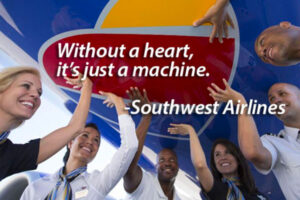 Organization, from the Latin word organum, means “to form into a whole consisting of interdependent parts.” By the mere nature of the word, organizations’ survival depends on many diverse individuals aligning to one common thread, the well-defined and profoundly understood mission/vision of the business. The following is a case study in application.
Organization, from the Latin word organum, means “to form into a whole consisting of interdependent parts.” By the mere nature of the word, organizations’ survival depends on many diverse individuals aligning to one common thread, the well-defined and profoundly understood mission/vision of the business. The following is a case study in application.
One of the clearest cases of excellent execution was Southwest Airlines in the mid to late 90’s. It didn’t matter the department, the individual, or the job; Southwest hired, promoted, and led in alignment with a strict edict of personality-based decisions. They were methodical in ensuring that the entire team understood the key to their survival in a highly competitive market was providing customers with an exceptional experience. The former CEO, Herb Kelleher, religiously opined about the fact that they were not in the ‘airline business’ but were in the ‘service business.’ He added that “all the other airlines have planes however, Southwest could corner the market on service.” And, that they did.
Southwest achieved top ‘Airline Quality Ratings’ and consistently led in customer satisfaction within the aviation industry. A famous example of this strict adherence occurred when a former captain of ‘Airforce 1’ applied for, and failed to achieve, a pilot’s role within Southwest’s inflight operations. As a highly decorated Airforce pilot, the individual was clearly shocked and confused at the decline to offer him a position. He called Kelleher directly. As the story goes, Mr. Kelleher was very matter of fact (in his typical humorous manner) with the applicant, stating that ‘the pilot’s arrogance preceded him.’ There was no way they could put him in front of customers, given that Southwest was ‘in the people business and that being a pilot was only part of what the job entailed.’ This profound alignment with the core business strategy has served Southwest well, now the second largest, domestic carrier in the United States. We can all agree that a “smile” won’t fly a plane. However, all things being equal, find the person who embodies the core strategic direction and culture of your organization to ensure operational efficacy and achievement.
To further illustrate the point I’m attempting to make, I’ll share another example of misaligned human capital strategy that occurred within the gaming and hospitality business. Although most certainly motivated properly to create a diverse workforce, this organization was most concerned with recruiting and promoting individuals regardless of strategic alignment with their core service strategy and culture. Furthermore, new hires weren’t effectively on-boarded or educated on the mission and vision of the company. The employees lacked a cohesive bond to the organization, its mission, and each other. While their employees were significantly diverse, they were not pulling together in a cohesive effort. The results could be found in all employee metrics starting with quality of applicant and low selection ratios, attendance challenges, key performance indexes and, of course, turnover.
An analogy for this misalignment is to consider you are in a lifeboat with many different people in the middle of the ocean. In order to survive and get to shore, everyone must pull their weight. One or two has boating knowledge and many have none, the people represent various mindsets and backgrounds, ages, hopes, and fears. These individuals, with their diverse thought and contribution, are rowing in different directions, creating chaos, and essentially causing the boat to go in circles without progressing toward shore and survival.
I believe the quote, “the road to hell is paved with good intentions” incapsulates the challenge here. As organizations rightfully focus on the diversity of their workforce, they must not lose focus on the fundamental stratagem of teamwork. There is no argument – we can all provide diverse thinking and more creative ways to “row.” However, we need to be “rowing” together. We cannot lose sight of the fact that when an individual chooses to work for an organization, they need to wholeheartedly commit to the organization’s mission and values, collaborate with their organizational team to achieve mutual goals, and leave their ego at the door.
By Kawel B. LauBach, MA







